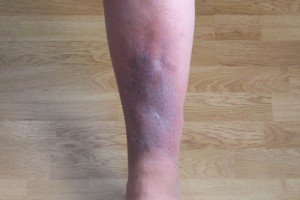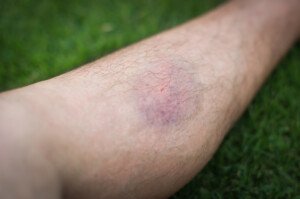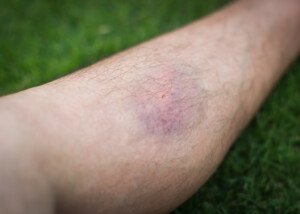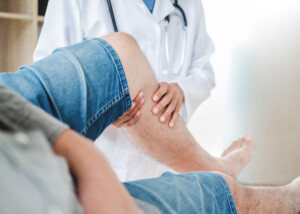Do you panic every time you see a new bruise on a leg because you think it could be a DVT?
Are you constantly checking your legs for new bruises and then anticipating that soon, you’ll see swelling and feel severe cramping from a deep vein thrombosis?
If you’ve been suffering from anxiety every time you discover a bruise on your lower or upper leg, and if you’re driven to inspect your legs on a daily basis to “catch a DVT early,” this means you already know that a deep vein thrombosis is a medical emergency because it can travel to the lungs and be fatal.
A DVT sometimes – not always – causes symptoms.
They include: swelling, redness, unusual warmth to the touch, pain and/or cramping.
But can they also cause the common bruise to appear – the mark you’d get if you bumped your leg hard into something or got hit there by a stray golf ball?
Or how about the type of bruising that turns up when you fall on the ground during sport or slip on ice?
Well, here’s some good news: A DVT won’t cause a bruise.
“The reason you don’t see a bruise with DVT is because it is in the deep vein — which is far from the surface of the skin,” says Dr. Lawrence Presant, DO, chief medical officer at Arizona Vein Specialists, and an expert on blood clots.
“You will not see bruising on the surface; however, with severe blood clots in the deep vein or in the arteries, you could see a dusky reddish or white coloration of the leg.”
These colorations in no way resemble those common-looking bruises that everyone gets on their legs sooner or later, and in many cases don’t even recall the event that put those bruises there in the first place.

DVT discoloration. Note that it looks nothing like the common bruise. Shutterstock/zusenjka
Also keep in mind that a harmless bruise will visibly change in color day by day, going from purple/red to brown or tan to green to yellow as it resolves.
One reason that a person, who’s prone to severe health anxiety, may start fixating on the idea of DVTs causing those common-appearing bruises, is because often, those purple, blue and green bruises seem to arise out of nowhere, for no reason.
The person doesn’t recall getting hit there. They’re sure they hadn’t accidentally walked into something in the dark.
So their vulnerable mind goes in the direction of something that might cause a bruise without getting struck in that spot: a blood clot.
However, it’s very common to get bruises without having to suffer from a memorable, painful strike in the leg. After all, skin isn’t made of steel.
If you “bruise easily,” maybe it’s because you’re bumping into things so often that these events don’t register on a conscious level unless they’re painful.
A common bruise can result from a non-painful contact.
For example, I’ve had mild bruising on my shins from gliding a barbell up my legs for the deadlift exercise – with sweat pants between my skin and the barbell.
This technique is NOT the least bit painful to my shins. But the mild bruising has been known to occur.
DVT Risk Factors
Frequent bumping of your legs into things such as a cocktail table, or your legs often getting hit during sport such as karate sparring, is NOT a risk factor for a blood clot – no matter how many “ugly” purple, blue, green, brown or yellow bruises you get or how dark purple and red and huge one might be. They are all superficial.
If you’re not moving around much, like after surgery or during long periods of sitting on a flight or as a passenger in a car, your DVT risk goes up.
This is because your blood flow slows down, making clots more likely to form.
Certain health conditions also raise the risk. If you have a family history of blood clots or conditions that affect blood clotting, like certain genetic disorders, you’re more susceptible.
Additionally, being overweight or obese puts extra pressure on your veins, which can contribute to clot formation.
Age plays a role too — being over 60 increases the likelihood of developing DVT.
Also, pregnancy and the use of birth control pills or hormone replacement therapy can change your blood’s clotting tendency.
Finally, if you have cancer or are undergoing cancer treatment, this can also heighten your risk.
Conditions that cause bruising include hemophilia, leukemia, liver disease and kidney disease.
The concerning factors are 1) a lot of bruises suddenly appearing when previously you never had this problem and have no explanation for them such as taking up a contact sport, and 2) other symptoms with the bruises such as joint pain, rashes, abdominal pain, fatigue and/or unexplained weight loss.
With all of that said — if your common-looking bruises come with no other issues and this seems to be your normal rather than a new-onset phenomenon — it’s time to stop inspecting them, feeling them and monitoring them.
They’re nothing more than a cosmetic nuisance that may not even be sore to the touch. Move on.
 Dr. Lawrence Presant, DO, is chief medical officer at Arizona Vein Specialists in Phoenix, and a certified diplomat of the American Board of Venous and Lymphatic Medicine. A vein surgeon specialist, his passion is phlebology, the diagnosis and treatment of painful and unsightly vein disorders.
Dr. Lawrence Presant, DO, is chief medical officer at Arizona Vein Specialists in Phoenix, and a certified diplomat of the American Board of Venous and Lymphatic Medicine. A vein surgeon specialist, his passion is phlebology, the diagnosis and treatment of painful and unsightly vein disorders.
 Lorra Garrick is a former personal trainer certified through the American Council on Exercise. At Bally Total Fitness she trained women and men of all ages for fat loss, muscle building, fitness and improved health.
Lorra Garrick is a former personal trainer certified through the American Council on Exercise. At Bally Total Fitness she trained women and men of all ages for fat loss, muscle building, fitness and improved health.
.










































